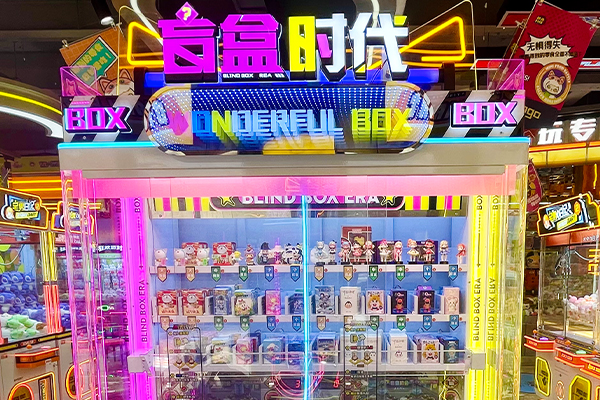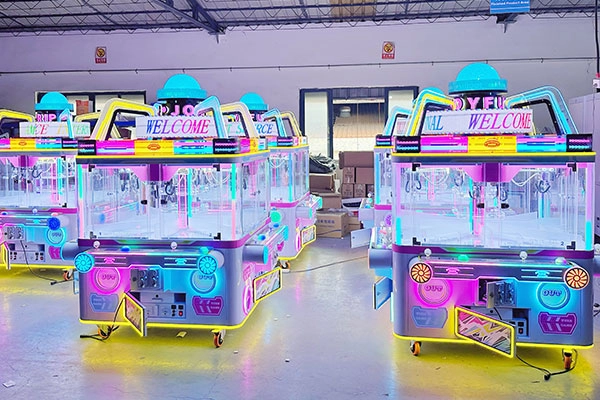Claw machines have become a popular entertainment option worldwide, offering a fun way for players to win prizes. These machines, commonly found in arcades, malls, and entertainment venues, have been a staple in the gaming industry for years. But how does the
claw machine business work, and what are the revenue streams that keep these machines profitable? This article delves into the business model of claw machines, focusing on how they generate income, the costs involved, and strategies to ensure a successful operation.
Introduction to Claw Machine Business
The claw machine business model revolves around providing entertainment and the chance to win prizes. These machines have been a consistent source of amusement for decades, drawing in players of all ages. The business itself is relatively simple—operators place these machines in high-traffic areas where customers pay to play in hopes of winning a prize.
Claw machines are designed to capture attention, with their flashing lights, enticing sounds, and the promise of winning a coveted prize. However, behind the bright exterior, the claw machine business requires careful planning and strategic operation. Operators need to understand location selection, maintenance, and profitability strategies to run a successful business.
How Does the Claw Machine Business Work?
The core of the claw machine business is its pay-to-play model. Players insert money or tokens into the machine and use the joystick to maneuver a mechanical claw. The goal is to grab a prize, typically stuffed toys, gadgets, or other small trinkets, and drop it into a prize chute. While the concept seems simple, claw machines are designed with varying levels of difficulty to ensure profitability for the operators.
The claw strength is adjustable, which directly affects the likelihood of winning a prize. Operators often set the strength low to ensure that the claw doesn’t grab prizes too easily. This, combined with the attraction of high-value prizes, creates a balancing act between player satisfaction and the operator's need to maintain a profitable business. By understanding this balance, operators can optimize their claw machine placements and ensure their business remains sustainable.
Revenue Streams of Claw Machine Businesses
Claw machine operators generate revenue through several key streams. Understanding these revenue sources is essential for ensuring a healthy profit margin. Let’s dive deeper into each stream.
Pay-Per-Play Model
The pay-per-play model is the most common revenue stream for claw machine operators. Players pay a set amount per game, typically between $1 and $5 depending on the location and the value of the prizes. This model generates immediate revenue for every game played. The key to profitability lies in the machine’s design, prize selection, and claw strength settings. Operators aim to set the claw strength low enough that the majority of players fail to win, but not so low that players stop trying altogether.
Prize Cost vs. Profit Margins
Another important revenue aspect is the cost of the prizes inside the claw machine. Operators need to carefully select affordable yet attractive prizes that can draw customers in. While some prizes may have a low upfront cost, they can still generate high demand. The operator must ensure that the cost of prizes is lower than the amount players spend on the machine. This creates a positive profit margin. For example, a stuffed toy purchased for $1 may attract players to spend $5, providing a $4 profit for each unsuccessful attempt.
Location Rental Agreements
In addition to direct revenue from gameplay, operators may also earn through location rental agreements. High-traffic locations such as malls, arcades, or entertainment centers typically charge a fee to host claw machines. This rental fee can be negotiated based on the expected foot traffic and potential revenue the machine can generate. Operators who place their machines in prime locations can earn a significant amount of revenue from these agreements, in addition to the pay-per-play revenue.
Costs and Profitability of Claw Machines
Claw machine operators need to manage several costs to ensure profitability. These include the initial cost of purchasing or leasing the machines, ongoing maintenance, prize procurement, and location fees. Understanding these costs is crucial for pricing games and selecting high-traffic locations.
The initial purchase or lease
cost of a claw machine can vary depending on its size and features. Basic machines may cost around $1,000, while more sophisticated ones with digital displays and interactive features may go for upwards of $5,000. Maintenance costs, including repairs and adjustments to the claw strength, also add up over time. Operators need to factor these expenses into their pricing structure to ensure profitability.
Key Strategies for a Successful Claw Machine Business
Success in the claw machine business relies on several key strategies, such as location selection, prize choice, and adjusting machine settings. Here are some effective strategies to help your claw machine business thrive.
Choosing High-Traffic Locations
Selecting high-traffic areas is crucial for the success of any claw machine business. Locations with heavy foot traffic, such as shopping malls, amusement parks, or movie theaters, offer the best potential for attracting customers. By placing machines in these prime spots, operators can maximize exposure and increase the chances of regular gameplay. It’s essential to choose places where potential customers are likely to stop and play, creating a steady flow of revenue.
Prize Selection and Psychology
Prize selection plays a critical role in the appeal of a claw machine. Operators should choose prizes that are visually appealing and desirable to the target audience. Items such as plush toys, action figures, or limited-edition collectibles often draw players in. Understanding the psychology behind prize selection is equally important—offering high-value prizes or themed prizes can encourage players to try their luck. By providing a range of attractive prizes, operators can appeal to different customer preferences and increase overall engagement.
Adjusting Claw Strength for Profitability
The claw strength is a key factor in determining profitability. Operators can adjust the strength of the claw to ensure a balance between player satisfaction and profitability. Setting the claw strength too high will lead to excessive wins, reducing profitability, while setting it too low can frustrate players and drive them away. A moderate, balanced claw strength that offers occasional wins while maintaining a high chance of failure is ideal for ensuring ongoing profitability.
Industry Trends and Future of Claw Machines
The claw machine industry is evolving with advancements in technology and changes in consumer preferences. Today, operators are exploring new ways to enhance the gameplay experience, such as incorporating interactive elements, digital screens, and custom-themed machines. As technology continues to improve, the potential for claw machines to offer more immersive and engaging experiences grows.
Additionally, the rise of online and digital arcade games is influencing the traditional arcade machine business. Some
claw machine manufacturers are integrating mobile apps and online platforms, allowing players to control machines remotely and win prizes from the comfort of their homes. This shift toward digital experiences may shape the future of the claw machine business and provide new opportunities for operators to expand their reach.
Conclusion
The claw machine business is a lucrative and exciting venture for operators who understand the balance between entertainment, prize selection, and profitability. By selecting the right locations, managing costs effectively, and adjusting claw strength, operators can create a sustainable and profitable business model. The future of the claw machine business looks bright, with new trends and technologies continuing to shape the industry.
If you’re interested in entering the claw machine business or upgrading your existing machines, consider exploring the products and services offered by YPFUNS, a leading manufacturer of claw machines. With over 14 years of experience, YPFUNS offers high-quality machines, OEM/ODM services, and expert support to help you succeed. Contact YPFUNS today to learn more about how they can help you take your claw machine business to the next level.
FAQs
Do claw machines have adjustable difficulty?
Yes, operators can modify claw strength to control win rates and profitability.
High-traffic areas like arcades, malls, movie theaters, and family entertainment centers perform best.
Are claw machines still profitable in 2024?
Yes, with strategic placement and smart prize management, claw machines remain a viable business.




















YPFuns Global
YPFuns Global
YPFUNS Global
YPFUNS Claw Machine